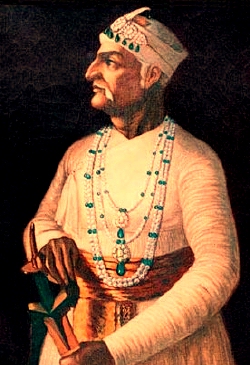Top Qs
Timeline
Chat
Perspective
Nizam Ali Khan, Asaf Jah II
18th-century , 5th Nizam of Hyderabad State From Wikipedia, the free encyclopedia
Remove ads
Mir Nizam Ali Khan Siddiqi, Asaf Jah II (7 March 1734 – 6 August 1803) was the 5th Nizam of Hyderabad State between 1762 and 1803. He was born on 7 March 1734 as fourth son to Asaf Jah I and Umda Begum. His official name is Asaf Jah II, Nizam ul-Mulk, Nizam ud-Daula, Nawab Mir Nizam 'Ali Khan Siddiqi, Fateh Jang, Sipah Salar, Nawab Subedar of the Deccan. Sawānih-i-Deccan, a Persian work compiled by Munim Khan, a military commander during the era of Asaf Jah II gave more insight about administration of Asaf Jahis.[1][2]
Remove ads
Remove ads
Nizam of Hyderabad
Faujdar of the Deccan
Nizam Ali was appointed as the leading commander and administrator of the Deccan in the year 1759, his successful methods of fighting against the Marathas had earned him much repute as a capable commander.
Shah Alam II' – Subedar of the Deccan
After the Marathas were routed during the Third Battle of Panipat in the year 1761, Nizam Ali and his army of 60,000 immediately advanced and repulsed them as far as Puna and forced them to sue for lasting peace.[need quotation to verify] Nizam Ali then seized the Bidar Fort and later arrested Salabat Jung, this action of Nizam Ali Khan was ratified by the Mughal Emperor Shah Alam II, who issued a Firman terminating Salabat Jung (supported by the French East India Company), from his position as the Subedar of Deccan and appointing Nizam Ali Khan Asaf Jah II as his successor.[3]
Supporting Shah Alam II
Immediately after recapturing the throne Shah Alam II in 1772, came under the influence of Nizam Ali Khan the Nizam of Hyderabad.

Remove ads
Nizam's intervention against the Peshwa
In 1757, the Nizam (Salabat Jung) was defeated by Sadashivraobhau in the Battle of Sindhkhed and again at the Battle of Udgir in 1760. In 1762, Raghunathrao allied with the Nizam due to mutual distrust and differences with Madhavrao Peshwa. The Nizam marched towards Poona, but little did he know that Rughunathrao was going to betray him. In 1763, Madhavrao I along with Rughunathrao defeated Nizam at Battle of Rakshasbhuvan and signed a treaty with the Marathas.[citation needed]
In 1795, he was defeated by Madhavrao II's Marathas at the Battle of Kharda and was forced to cede Daulatabad, Aurangabad and Sholapur and pay an indemnity of Rs. 30 million.[4]
A French general, Monsieur Raymond, served as his military leader, strategist and advisor.[5]
Remove ads
Fall of Mysore
The following year, he realized that the fall of Tipu Sultan was imminent and thus, he entered into a Subsidiary alliance with the British East India Company.[6] Thus Hyderabad, which is in both area and population comparable to the United Kingdom, became a princely state within the British Raj. [citation needed]
Death
Asaf Jah II died at Chowmahalla Palace, Hyderabad at the age of 69 on 6 August 1803.
Family
- Consorts
- Bakhshi Begum (died on 21 December 1813,[7] buried in Makkah Masjid, Hyderabad),[8] Nizam's favourite wife;[9]
- Tinat-un-Nisa Begum (buried in Makkah Masjid, Hyderabad),[8] a servant in service of Bakhshi Begum, and mother of Sikander Jah, Asaf Jah III[9] and Akbar Jah;[10]
- Burhanpuri Begum (buried in Makkah Masjid, Hyderabad), mother of Jahandar Jah;[8]
- Dil Lagan Bai (died 3 June 1809), mother of a son born on 25 November 1777;[11]
- Daughters
- Fakhr-un-Nisa Begum also known as Manjli Begum, married to Fathyab-ud-Daulah, the grandson of Khaja Hamid Khan, the uncle of Asaf Jah I;[12]
- Sajida Begum, married to Mir Qudrut Ullah Khan, Ibrat Jung, son of Shuja-ul-Mulk;[13]
- Naqsh Bandi Begum (died 18 November 1808, buried in Hazrat Barhana Sahib Dargah), married to Mahabat Jung;[14]
- Basheer-un-Nisa Begum, married in 1800 to Amir-i-Kabir I, the first princess to be married in Paigah;[15]
- Imami Begum (buried in Makkah Masjid, Hyderabad);[8]
- A daughter married to the son of Shuja-ul-Mulk (died 23 December 1788);[16]
- A daughter married on 5 September 1776 to Zulfiqar-ud-Daulah Bahadur, son of Basalat Jung;[17]
- Riyaz-un-nisa Begum (died 3 June 1809), married to Khan-i-Shiraz;[18]
- A daughter married to Dara Jah;[19]
Remove ads
See also
References
Bibliography
External links
Wikiwand - on
Seamless Wikipedia browsing. On steroids.
Remove ads

